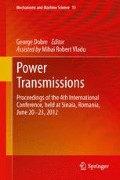Abstract
Even if it seems simple, the design of the rolling bearings is a difficult task for mechanical engineering. Their specific structure and the involved tribological phenomena in their operation lead to many and complex calculations of rolling bearings. Consequently, to find the optimal design of the rolling bearings the Multi-Objective Optimization should be used. In this paper, two objective functions (the basic dynamic radial load rating of the bearing and the minimum thickness of the elastohydrodynamic film between rollers and raceways) are optimized using multi-objective Evolutionary Algorithms (EAs) in order to obtain the optimal design of a single-row cylindrical roller bearing. Three design variables (the complex factor γ, the roller diameter, and the roller length) were used to fully, completely, and uniquely describe the bearing geometry and to construct the objective functions and the constraints. To solve this optimal design problem the authors used Cambrian optimization platform.
Access this chapter
Tax calculation will be finalised at checkout
Purchases are for personal use only
Abbreviations
- B :
-
Bearing width, \( B = 100\,{\text{mm}} \)
- C r :
-
Bearing dynamic radial load rating, N
- d :
-
Bore diameter of the bearing, \( d = 460\,{\text{mm}} \)
- D :
-
Outer diameter of the bearing, \( D = 680\,{\text{mm}} \)
- D pw :
-
Pitch diameter, mm
- D we :
-
Roller diameter, mm
- F r :
-
Bearing radial load, N
- G :
-
Material parameter
- h min_i :
-
Minimum lubricant film thickness in inner ring raceway-roller line contact, μm
- h min_o :
-
Minimum lubricant film thickness in outer ring raceway-roller line contact, μm
- i :
-
Number of roller rows
- I :
-
Maximum interference, mm
- L w :
-
Roller length, mm
- L we :
-
Effective roller length, mm
- Q :
-
Radial load acting on the most loaded roller, N
- R r :
-
Reduced curvature radius of the contact, mm
- U :
-
Speed parameter
- W′:
-
Load parameter
- Z :
-
Numbers of rollers
- α :
-
Nominal contact angle, rad
- γ :
-
Complex factor
- δ c :
-
Tenon thickness, mm
- δ cmin :
-
Minimum tenon thickness, mm
- δ i :
-
Inner ring thickness, mm
- δ imin :
-
Inner ring minimum thickness, mm
- δ o :
-
Outer ring thickness, mm
References
Chakrabotrhy I, Vinay K, Nair SB, Tiwari R (2003) Rolling element bearing design through genetic algorithms. Eng Optimisation 35(6):649–659
Dowson D, Higginson GR (1966) Elasto-hydrodynamic lubrication. Pergamon Press, Oxford
Gupta S, Tiwari R, Nair SB (2006) Multi-objective design optimisation of rolling bearings using genetic, Mechanism and Machine Theory
Harris TA, Kotzalas MN (2007) Essential concepts of bearing technology, rolling bearing analysis, 5th edn. Taylor and Francis, London
Rao BR, Tiwari R (2007) Optimum design of rolling element bearings using genetic algorithms. Mech Mach Theory 42(2):233–250
Rao VR, Savsani JV (2012) Mechanical design optimization using advanced optimization techniques. Springer, London
Sivanandam SN, Deepa SN (2008) Introduction to genetic algorithms. Springer, Berlin Heidelberg
Tudose L, Ştefanache C (2007) Cambrian application package for mono and multi-objective. In: The 1st international conference advanced engineering in mechanical systems, ADEMS’07, Cluj-Napoca, in Acta Technica Napocensis, series: applied mathematics and mechanics, Nr. 50, vol 2, pp 367–374, 7–8 June
Yu X, Gen M (2010) Introduction to evolutionary algorithms. Springer, London
Acknowledgments
This paper was co-supported by the RKB Group, the Swiss bearing manufacturer and the project “Doctoral studies in engineering sciences for developing the knowledge based society-SIDOC” contract no. POSDRU/88/1.5/S/60078, project co-funded from European Social Fund through Sectorial Operational Program Human Resources 2007–2013. The authors greatly appreciate and wish to thank all the RKB staff for their great assistance during this project.
Author information
Authors and Affiliations
Corresponding author
Editor information
Editors and Affiliations
Rights and permissions
Copyright information
© 2013 Springer Science+Business Media Dordrecht
About this paper
Cite this paper
Tudose, L., Kulcsar, G., Stănescu, C. (2013). Pareto Approach in Multi-Objective Optimal Design of Single-Row Cylindrical Rolling Bearings. In: Dobre, G. (eds) Power Transmissions. Mechanisms and Machine Science, vol 13. Springer, Dordrecht. https://doi.org/10.1007/978-94-007-6558-0_41
Download citation
DOI: https://doi.org/10.1007/978-94-007-6558-0_41
Published:
Publisher Name: Springer, Dordrecht
Print ISBN: 978-94-007-6557-3
Online ISBN: 978-94-007-6558-0
eBook Packages: EngineeringEngineering (R0)

